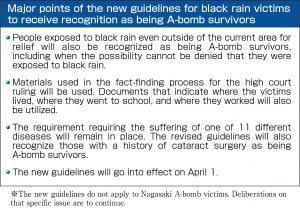MHLW announces new guidelines for providing aid to “black rain” victims, including cases in which exposure cannot be denied
Mar. 19, 2022
Estimates project 11,000 people will newly be granted recognition as A-bomb survivors
by Koji Higuchi and Junji Akechi, Staff Writers
On March 18, Japan’s Ministry of Health, Labour and Welfare (MHLW) informed the local governments concerned of its newly formulated guidelines designed to provide relief to an expanded number of “black rain” victims. The new guidelines, which will take effect on April 1, stipulate that people who experienced black rain after the Hiroshima atomic bombing will be recognized as being A-bomb survivors, including in cases where the possibility of exposure to black rain “cannot be denied,” based on confirmation of residence in the area backed up by student registration records and other documents. MHLW estimates project that the revised guidelines will lead to more than around 11,000 people being newly certified as A-bomb survivors.
Necessary conditions for providing recognition that people were exposed to black rain include black rain exposure being impossible to deny as well as applicants being exposed to the rain and their clothes wet as a result. Decisions on providing recognition will be made using such materials as family registry information, student registration records showing where the applicants lived or where they went to school, and materials related to places of employment.
Even as the revised guidelines keep in place the requirement that the victims suffer from among 11 diseases, such as cancer, cataracts, and disorders of the hematopoietic (blood-formation) system, official recognition will be provided to those undergoing cataract surgery as being A-bomb survivors if records exist of their surgery even if cataract symptoms are not present currently and there is no proof that the eye disease was caused by radiation.
The impetus for revision of the guidelines was a ruling handed down by the Hiroshima High Court in July 2021. The ruling provided recognition to all 84 plaintiffs in the court case who were outside the government-designated area for relief as being A-bomb survivors. Yoshihide Suga, Japan’s prime minister at the time, accepted the ruling, and the Suga Cabinet adopted the official statement by the prime minister that the national government would extend relief to “those who were in similar situations as the plaintiffs.” The information used in the fact-finding process for the high court ruling will also be applied in the examination of such individual cases in the future.
The ministry began holding discussions with the Hiroshima and Nagasaki Prefectural and City governments in the fall of last year. In December, the ministry proposed a set of amendments that would provide relief to Hiroshima victims only. The new guidelines do not include those who were exposed in the atomic bombing of Nagasaki outside the area designated by the national government, an issue regarding which all parties will continue to deliberate in the future.
The Hiroshima Prefectural and City governments have already received around 2,000 applications for Atomic Bomb Survivor’s Certificates, and the governments will begin granting recognition on April 1. Staff at the city government’s Relief Division said, “The national and Hiroshima Prefectural and City governments have held a series of concrete, working-level discussions. We hope to issue the certificates in as timely a fashion as possible.”
“Black rain” refers to the rain containing radioactive materials that fell after the atomic bombing on Hiroshima by the United States. The government has designated an area measuring around 19 kilometers in length and 11 kilometers in width stretching northwest of the hypocenter as the heavy rain area subject to relief. Those who were exposed to the black rain in that area at the time are entitled to receive free medical examinations. If such people are diagnosed as having one of the specific diseases, they are eligible to receive an Atomic Bomb Survivor’s Certificate.
(Originally published on March 19, 2022)








